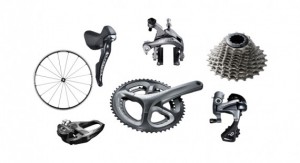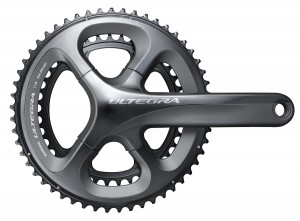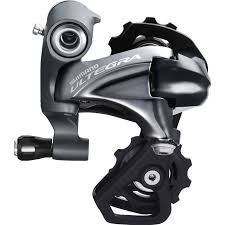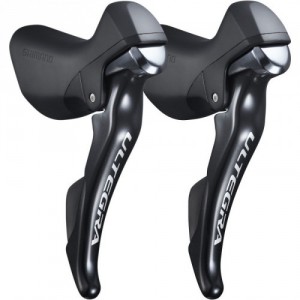Shimano Ultegra 6800 Review/Overview
By Jim Weaver, Service Manager, Fit Werx, VT I just finished building our first bike equipped with Shimano’s new Ultegra 6800 “11 speed” mechanical groupset. The “11 speed” refers to the rear cassette that now contains 11 cogs. Shimano came out with the Dura Ace 9000 “11 speed” group over the winter, and they have now followed up with the new companion Ultegra group. So, the question is, how does the new Ultegra work, and how does it stack up against the Dura Ace?
I just finished building our first bike equipped with Shimano’s new Ultegra 6800 “11 speed” mechanical groupset. The “11 speed” refers to the rear cassette that now contains 11 cogs. Shimano came out with the Dura Ace 9000 “11 speed” group over the winter, and they have now followed up with the new companion Ultegra group. So, the question is, how does the new Ultegra work, and how does it stack up against the Dura Ace?
Component by component, the new Ultegra has essentially the same design as the Dura Ace, with minor exceptions. Visually, the only difference is the finish as the Dura Ace is finished in combinations of gloss black and polished chrome while the Ultegra components is similar to the previous generation Ultegra (i.e. gray, sort of between a matte and high gloss finish). I find the Ultegra 6800 attractive in a more understated way.
 The new Ultegra crankset has the same asymmetrical four arm design as the Shimano Dura Ace 9000. Shimano feels that this design strengthens the crankset at the point where maximum pressure is being applied to the crank arms, while being lighter than before. Functionally, the Ultegra 6800 crank is the same as the Dura Ace and less than 10 grams heavier while offering half the friction compared to the previous generation Ultegra crank. As with Dura Ace, the crank “spider” is sized so that the same crank can accommodate both compact chainrings (50/34), standard (53/39), and the newly popular 52/36 combination. The Dura Ace 9000 crank is very stiff, and it is hard to tell whether there is a big difference in this regard going to Ultegra 6800, but it seems unlikely as both are plenty stiff for almost everyone. This means the biggest differences between the two cranks are the ultra-low friction, extra durability coating on the Dura Ace and the polished finish.
The new Ultegra crankset has the same asymmetrical four arm design as the Shimano Dura Ace 9000. Shimano feels that this design strengthens the crankset at the point where maximum pressure is being applied to the crank arms, while being lighter than before. Functionally, the Ultegra 6800 crank is the same as the Dura Ace and less than 10 grams heavier while offering half the friction compared to the previous generation Ultegra crank. As with Dura Ace, the crank “spider” is sized so that the same crank can accommodate both compact chainrings (50/34), standard (53/39), and the newly popular 52/36 combination. The Dura Ace 9000 crank is very stiff, and it is hard to tell whether there is a big difference in this regard going to Ultegra 6800, but it seems unlikely as both are plenty stiff for almost everyone. This means the biggest differences between the two cranks are the ultra-low friction, extra durability coating on the Dura Ace and the polished finish.
The front derailleur of the new Dura Ace provides two different ways to route the cables as different frame designs run the derailleur cable at different angles as it enters the derailleur. Having two separate routings on the front derailleur allows for the angle of the cable to be optimized for maximum shifting efficiency. The Ultegra front derailleur lacks this feature and the front shifting is slightly less precise than the Dura Ace. Be that as it may, the front shifting on Ultegra 6800 is better than the previous generation, which was pretty darn good and few would notice a difference out of the box. Like Dura Ace 9000, the overall improvement is that the latest generation of front shifting requires less effort through a combination of both derailleur and shifter design.
 The new rear derailleur has the same overall design as Dura Ace, except that it comes in both a standard and a long cage version. The short cage will handle cassettes with up to a 28 tooth sprocket while the long cage version will handle up to a 32 tooth sprocket. As a result, you can have a compact crankset with a smallest chainring of 34 teeth, coupled with a 32 tooth rear gear, offering great gearing for those of us who struggle up some of the steepest and longest climbs. Both Dura Ace 9000 and Ultegra 6800 rear derailleurs use Shimano’s new Vivid Index technology that helps smooth downshifts and keep shifter feel and action across the full range of gearing as consistent. As has been the case for awhile, the Dura Ace 9000 rear derailleur uses ball bearing pulleys in both pulleys (Ultegra 6800 uses a bushing in the upper), more titanium and lighter alloys, and higher grade bushings to minimize weight and maximize long-term durability and performance with use.
The new rear derailleur has the same overall design as Dura Ace, except that it comes in both a standard and a long cage version. The short cage will handle cassettes with up to a 28 tooth sprocket while the long cage version will handle up to a 32 tooth sprocket. As a result, you can have a compact crankset with a smallest chainring of 34 teeth, coupled with a 32 tooth rear gear, offering great gearing for those of us who struggle up some of the steepest and longest climbs. Both Dura Ace 9000 and Ultegra 6800 rear derailleurs use Shimano’s new Vivid Index technology that helps smooth downshifts and keep shifter feel and action across the full range of gearing as consistent. As has been the case for awhile, the Dura Ace 9000 rear derailleur uses ball bearing pulleys in both pulleys (Ultegra 6800 uses a bushing in the upper), more titanium and lighter alloys, and higher grade bushings to minimize weight and maximize long-term durability and performance with use.
The Ultegra 6800 STI shift levers have the same revised shape as Dura Ace 9000 and the reach adjustment on the new Ultegra is the same as the new Dura Ace, allowing for 10mm of lever adjustment. This reach adjuster replaces the rather primitive rubber spacer based reach adjustment from Ultegra 6700. Now, the reach to the shift levers is adjusted through a screw that allows for much finer adjustment, the same as on Dura Ace.  The shifter “throw” is shorter than before, with a more definite click that now more accurately matches the point where the gear actually changes. The new Ultegra 6800 front STI shifter also has the same trim function as Dura Ace, designed to mimic the function of the Di2 front derailleur. When shifting into the small chainring, there are two stops and the first stop will engage the chain on the small chainring, but may have a bit of chain rub on the derailleur. You then click the shifter again, and the derailleur moves inward a bit further to eliminate the chain rub. The result is that over-shifting to the inside is virtually eliminated except under very extreme circumstances. This all being said, I still recommend a chain catcher on any carbon fiber bike, just in case!
The shifter “throw” is shorter than before, with a more definite click that now more accurately matches the point where the gear actually changes. The new Ultegra 6800 front STI shifter also has the same trim function as Dura Ace, designed to mimic the function of the Di2 front derailleur. When shifting into the small chainring, there are two stops and the first stop will engage the chain on the small chainring, but may have a bit of chain rub on the derailleur. You then click the shifter again, and the derailleur moves inward a bit further to eliminate the chain rub. The result is that over-shifting to the inside is virtually eliminated except under very extreme circumstances. This all being said, I still recommend a chain catcher on any carbon fiber bike, just in case!
Shimano introduced newly designed brake and derailleur cables and housings with the Dura Ace 9000 groupset and Ultegra 6800 uses these same improved cables and housings. The cables have a polymer coating that mores more smoothly through the housings than the previous generations’ stainless steel cables. The housings have a new lining that facilitates the smooth movement of the cables. The cables also have the same dedicated cable ends as Dura Ace 9000 that prevent friction between the cable and cable stops, improving cable movement, while also protecting the polymer coating from abrading and fraying. While cable technology may sound boring, the shifting and braking advantages of the new cables and housings is not just theoretical but of practical benefit, offering a very tangible benefit in terms of smoother and lighter operation. The new cables and housings also offer superior brake modulation when compared to the previous generation brakes and my only concern is the durability of this coating, and whether inevitable fraying of the coating will cause possible future shifting problems. I am sure Shimano has thoroughly tested this, so my concerns are likely unfounded.
When it comes to the cassette, the Ultegra 6800 cassette has an alloy sprocket carrier, while the Dura Ace’s is carbon fiber. The Ultegra sprockets are a steel alloy, while Dura Ace uses titanium for the 16 tooth and larger sprockets. The result of these differences is that the Dura Ace cassette is a notable 50-80 grams lighter in a given gearing combination. The Ultegra cassette comes in 11-23, 11-25, 12-25, 11-28 and, new for Shimano, an 11-32. The 11-32 is a notable difference that is not available in Dura Ace 9000 currently and helps Shimano compete with SRAM on wide ratio gearing options.
As with the other components, the new Ultegra brake calipers have the same general design as the Dura Ace 9000 calipers, but use some different materials, finish and pivots to save dollars. The Ultegra 6800 brake calipers now offer adjustable spring tension, the same as Dura Ace 9000, and I generally like to fully tighten the rear brake caliper spring tension while keeping the front at a more moderate to light setting to account for the loss of feel in the rear brake, due to cable housing flex; adjusting the rear brake tension up can help balance out lever feel. The previous generation Ultegra calipers did not offer this adjustment and this update is an example of attention to details by Shimano that, when added together, improve the overall riding experience. Compared to Ultegra 6700, brake feel is lighter, with better modulation, and from my initial ride, better braking power. As has always been the case, Dura Ace 9000 brake calipers pivot on bearings to maximize long-term smooth operation and durability while Ultegra brakes use bushings.
Out of the box, the shifting action and feel of the Ultegra 6800 system is very similar to the new Dura Ace 9000. They both have a lighter, more positive feel than the previous generation of either group, with shorter lever throws. One of my few complaints about previous generation Shimano shifters is that the point in the swing of the shift lever where the gear would actually change was a bit vague, and could vary from bike to bike. The point of actual gear engagement is now more immediate and predictable. To me, there is little difference in feel between the Ultegra and Dura Ace shifting out of the box. The new Ultegra 6800 had a slightly more “notchy” feel than Dura Ace when on the workstand, but that disappeared when I actually rode the bike. If pressed to find a difference, I would say that the Dura Ace has a slightly more positive feel. I leave it to those more sensitive and perceptive than I to find any other difference in feel between the two. Both are definite improvements over the previous generation of each and the differences between the two levels is most likely to show up many miles down the road when the higher end materials and tolerances on the Dura Ace will likely keep the lever feeling crisp and new longer.
So, is the new 6800 groupset an improvement over the 6700? Most definitely and in far more ways than simply one more sprocket in the cassette. It is lighter and offers smoother and improved shifting and braking and more gearing options; it simply works better than Ultegra 6700 in all departments. This is saying a great deal, as the previous generation of Shimano components was very good. But, how does the Ultegra 6800 groupset compare to the new Dura Ace 9000? Also very favorably. The differences between the two levels are much the same as with the previous generation of these components. The Dura Ace has a higher grade of finish, each of the Dura Ace components is lighter than the comparable Ultegra component (about 350 grams difference as a group), and the Dura Ace 9000 bearings and bushings are of a higher grade and used a bit differently, increasing longevity of the components. Dura Ace has a few small design differences as Dura Ace 9000 is the best Shimano has to offer, but Ultegra 6800 is only a small step behind. Great stuff and an excellent value that is going to bring leading edge technology to a wider range of rider!

